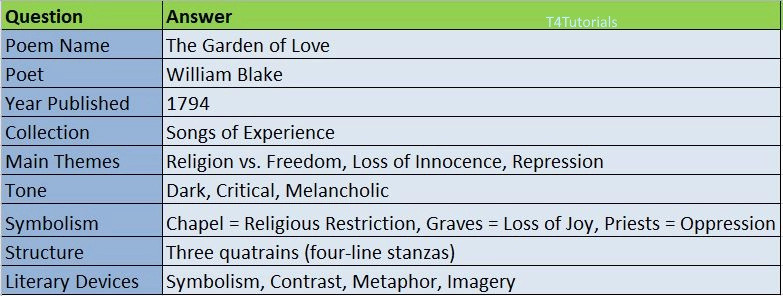Summary:
The Garden of Love is a poem from Songs of Experience (1794) by William Blake, depicting the corruption of innocence by institutionalized religion.
- The speaker visits the Garden of Love, expecting it to be a place of joy and freedom, but instead finds a chapel built in its place.
- The chapel has “Thou Shalt Not” written over the door, symbolizing restrictive religious doctrines.
- Instead of children playing freely, the garden is now filled with graves and priests in black robes, signifying death, repression, and sorrow.
- The poem criticizes organized religion, suggesting that it destroys natural human joy, love, and freedom.
- It contrasts the innocence of childhood with the harsh restrictions of adulthood, shaped by religious and societal rules.
Blake uses powerful imagery and contrast to convey how experience corrupts the joys of life, replacing them with rules, restrictions, and suffering.

10
Score: 0
Attempted: 0/10
Subscribe
Score: 0
Attempted: 0/10
Subscribe
| Question | Answer |
| Poem Name | The Garden of Love |
| Poet | William Blake |
| Year Published | 1794 |
| Collection | Songs of Experience |
| Main Themes | Religion vs. Freedom, Loss of Innocence, Repression |
| Tone | Dark, Critical, Melancholic |
| Symbolism | Chapel = Religious Restriction, Graves = Loss of Joy, Priests = Oppression |
| Structure | Three quatrains (four-line stanzas) |
| Literary Devices | Symbolism, Contrast, Metaphor, Imagery |